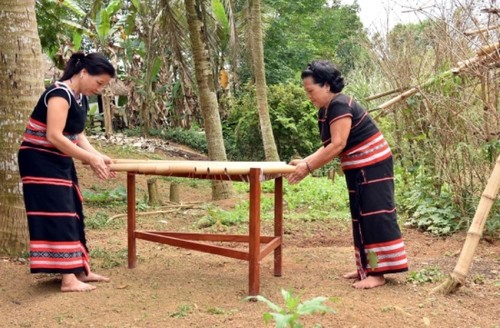 Artist Y Sinh (R) teaches a Xo Dang woman play Klông Put. (photo: Thanh Thuan, Báo Biên phòng) Artist Y Sinh (R) teaches a Xo Dang woman play Klông Put. (photo: Thanh Thuan, Báo Biên phòng) |
The Xo Dang in Kon Tum province has a range of musical instruments such as the T’rưng, K'lông Pút, water flute, drum, gong, horn, and percussion tube.
T’rưng and K'lông Pút are the two most popular wind instruments made of bamboo.
Phan Van Hoang, Deputy Director of the Kon Tum provincial Department of Culture, Sports, and Tourism, said: “While working on the fields, they created the musical instruments. The K'long Put is often played by women, 2 to 3 people playing at the same time. Gongs are often played by men. The ensemble usually has T'rung, K'long Put, gongs, and other musical instruments.”
The T’rung is made of bamboo tubes tied together by small, durable, strong strings. Each bamboo tubehas an air and resonator part. The two parts combine to create standard pitch and resonance. To adjust the sound of each tube, the maker has to meticulously sharpen the mouth of the tube.
The K'long Put is made from “nứa”, a variety of bamboo plant. The players clap their hands at the mouth of the tubes to make resonance sound. A K'long Put usually has from 7 to 10 tubes depending on the player’s style. The tubes are tied together and placed on a stone slab or a tree trunk when playing.
People believe that the bamboo tubes used to make the K'long Put are closely associated with the bamboo containers of seeds and the soul of rice resides in the bamboo tubes. When they play the K'long Put, the rice grows well to have bumper crop. The sound of the wind instrument also helps ward off wild animals.
Emeritus Artist Y Sinh of the Xo Dang group in Kon Tum province, said: “In the past, they would play the K’long Put in many days of to celebrate good crops. For example, when the rice grew well signaling a good harvest, people celebrated at the Rong communal house. They played the K’long Put and T’rung to the rhythm of the gongs. Now we play the T’rung to entertain tourists, mostly those from Japan, South Korea, and China.”
The water musical instrument is unique of the Xo Dang. It consists of bamboo tubes of different lengths, hung vertically on the stream bank. Water flows into large tubes to create low sounds while short tubes create high sounds.
Emeritus artist Y Sinh said: “The water musical instrument is difficult to make. Now very few old people can do it. Water runs into small and large pipes to produce beautiful sounds. When we walk near a stream, you will hear the impressive sound and see the water instrument.”
At any community event, the worshiping ritual is followed by the festival when all people sing and dance to the sounds of traditional musical instruments.
Phan Van Hoang, Deputy Director of the Kon Tum provincial Department of Culture, Sports, and Tourism, said: “The cultural sector organizes art troupes to perform at Vietnam Cultural Heritage Day and programs organized by the Ministry of Culture, Sports, and Tourism. These are venues for ethnic groups to show their cultural identities. Through cultural exchanges, they have transferred traditional cultural values to the younger generation.”
Ethnic villages in Kon Tum province have formed art groups to perform at community events and teach young people to play many traditional musical instruments as a way to preserve their culture.